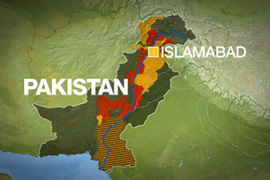Anger over Pakistan flood response
Survivors say government failed to come to their rescue following floods that have affected 2.5 million.

“The government is not helping us… the school building where I sheltered is packed with people, with no adequate arrangement for food and medicine,” the 53-year-old said.
Criticism ‘justified’
Farhatullah Babar, a spokesman for Asif Ali Zardari, Pakistan’s president, told Al Jazeera that survivors had “every right” to criticise the government.
“I think their criticism will persuade the government to do even more than it is doing,” he said.
| in depth | |||||||||||||||||
|
“We really sympathise with those who are marooned and those who have lost lives and relatives. They are justified in criticising because after all, they are the people who are suffering.”
Babar said that the cost of the clean-up may run into billions of dollars. President Zardari has set up a special unit to co-ordinate the response to the disaster and is watching the situation closely as he continues a trip to France.
The government has issued a flood warning for the southern province of Sindh, where heavy rain was expected on Monday night.
International donors have pledged millions of dollars in aid to help the survivors.
The crisis developed after “unprecedented” monsoon rains caused rivers to burst their banks, washing away entire villages, bridges and triggering deadly landslides.
Al Jazeera’s Sohail Rahman, reporting from Mingora in the Swat Valley, one of the worst affected areas, said “it’s breathtaking to see the damage that has been caused.”
“There are no formal relief camps in the region of Swat,” he said.
“They can’t situate them anywhere because if these rains come again, these camps could just as well be swept away. There are some feeding stations though.”
He said about 100,000 people were getting food from such stations at the outskirts of Peshawar.
Farmland destroyed
Thousands of homes and vast swathes of farmland have been destroyed in Khyber Pakhtunkhwa, one of Pakistan’s poorest regions.
Several camps, offering food and medicine, have been set up in community centres by provincial and relief organisations in different parts of the country.
| AFFECTED AREAS |
|
|
Concerns have been raised over the threat of disease as survivors arrived in camps with fever, diarrhoea and skin problems.
“Our doctors have treated over 600 people just in the last two days and they are seeing a lot of cases of diarrhoea, fever and skin infections,” Sonia Cush, the director of emergency response at Save the Children in Washington, DC, told Al Jazeera.
“We currently have emergency health teams moving around within the affected area treating people who urgently need healthcare, and our priorities are food, clean drinking water, healthcare and hygiene materials to ward off diseases.
“We will be distributing plastic sheeting to build makeshift shelters, but the hard work will only begin once the flood waters start to recede.”
Officials from Unicef, the United Nations’ children fund, said contaminated flood waters and lack of clean water could increase the risk of the spread of diarrhoeal diseases.
Children under five are especially vulnerable to dehydration from diarrhoea. With more than 40 per cent of the population under 18 years of age, the number of children affected could be in the hundreds of thousands, they said.
The UN has pledged $10m to help in the crisis, as has the US, which has also rushed rescue helicopters and boats to Pakistan to reach survivors who have been cut off by the floods.

